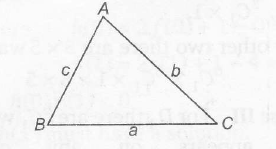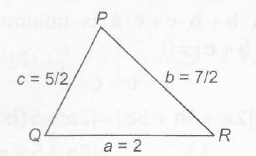Answer:
Option C
Explanation:
Concept involved if $\triangle ABC$ has sides a, b, c then,

$\tan (A/2)=\sqrt{\frac{(s-b)(s-c)}{a(s-a)}}$
where, $s=\frac{a+b+c}{2}$
Sol ,$s= \frac{2+\frac{7}{2}+\frac{5}{2}}{2}=4$
$\therefore$ $\frac{2 \sin P-\sin 2P}{2 \sin P+\sin 2p}=\frac{2 \sin P(1-\cos P)}{2 \sin P(1+\cos P)}$
$= \frac{2 \sin^{2}(P/2)}{2 \cos^{2}(P/2)}=\tan^{2}(P/2)$

$\Rightarrow$ $\frac{(s-b)(s-c)}{s(s-a)} \times \frac{(s-b)(s-c)}{(s-b)(s-c)}$
$\Rightarrow$ $\frac{((s-b)(s-c)^{2})}{\triangle^{2}}= \frac{\left(4+\frac{7}{2}\right)^{2}\left(4-\frac{5}{2}\right)^{2}}{\triangle^{2}}$
=$(\frac{3}{4 \triangle})^{2}$